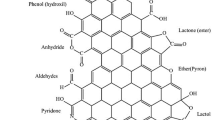Abstract
In present study, activated carbon is prepared by controlled pyrolysis of acrylic fibrous waste under the layer of charcoal using physical activation in high temperature furnace. The main objective is to study the effect of four factors (i.e. final pyrolysis temperature, holding time at final temperature, heating rate per hour, and number of steps) on carbonization behavior of acrylic fibrous waste. The Box-Behnken design and response surface modeling was performed to get higher specific surface area and higher electrical conductivity. The development of porous morphology having higher surface area is found to increase with increase in pyrolysis temperature, increase in number of steps, decrease in holding time and decrease in heating rate till some optimum value. This behavior is attributed to gradual reaction of atmospheric oxygen with carbonized acrylic fibrous waste, which resulted into the opening of previously inaccessible pores through the removal of tars and disorganised carbon. Moreover, these four factors also found to have significant effect on the development of electrical conductivity of activated carbon. Later on, the carbonized acrylic fibrous waste was pulverized in dry conditions by high energy planetary ball milling to get activated carbon nanoparticles. In addition to refinement of size, the specific surface area and electrical conductivity of pulverized carbon particles was found to increase with increase in milling time. The activated carbon particles obtained after three hours of dry milling revealed the particle size of 521 nm, the electrical conductivity of 21.78 s/m for 0.5 wt % concentration of aqueous dispersion and the specific surface area of 432 m2/g.
Similar content being viewed by others
References
N. M. Nor, L. C. Lau, K. T. Lee, and A. R. Mohamed, J. Environ. Chem. Eng., 1, 658 (2013).
D. Angin, E. Altintig, and T. E. Kose, Bioresource Technol., 148, 542 (2013).
J. Y. Yoo, C. J. Park, K. Y. Kim, Y. S. Son, C. M. Kang, J. M. Wolfson, I. H. Jung, S. J. Lee, and P. Koutrakis, J. Hazard Mater, 289, 184 (2015).
E. Gallego, F. J. Roca, J. F. Perales, and X. Guardino, Build Environ., 67, 14 (2013).
P. H. Wang, Z. R. Yue, and J. Liu, J. Appl. Polym. Sci., 60, 923 (1996).
M. C. W. Kwong, C. Y. H. Chao, K. S. Hui, and M. P. Wan, Atmos Environ., 42, 2300 (2008).
Okubo, T. Kuroki, and N. Saeki, Thin Solid Films, 519, 6994 (2011).
E. Ekrami, F. Dadashian, and M. Soleimani, Fiber. Polym., 15, 1855 (2014).
C. I. Su and C. L. Wang, Fiber. Polym., 8, 482 (2007).
M. A. Sidheswaran, H. Destaillats, D. P. Sullivan, S. Cohn, and W. Fisk, Build Environ., 47, 357 (2012).
A. Z. Muhammad Abbas, A. Yoshimasa, and M. Machidaa, J. Hazard Mater., 180, 552 (2010).
G. S. Bhat, F. L. Cook, A. S. Abhiraman, and L. H. Peebles, Carbon, 28, 377 (1990).
S. K. Theydan and M. J. Ahmed, Powder Technol., 224, 101 (2012).
M. A. Nahil and P. T. Williams, J. Anal. Appl. Pyrol., 91, 67 (2011).
P. Soraia and T. P. Silvestre, Waste Manage, 31, 378 (2011).
V. Baheti and J. Militky, Fiber. Polym., 14, 133 (2013).
V. Baheti, J. Militky, and M. Marsalkova, Polym. Compos., 34, 2133 (2014).
Author information
Authors and Affiliations
Corresponding author
Rights and permissions
About this article
Cite this article
Baheti, V., Naeem, S., Militky, J. et al. Optimized preparation of activated carbon nanoparticles from acrylic fibrous wastes. Fibers Polym 16, 2193–2201 (2015). https://doi.org/10.1007/s12221-015-5364-0
Received:
Revised:
Accepted:
Published:
Issue Date:
DOI: https://doi.org/10.1007/s12221-015-5364-0




